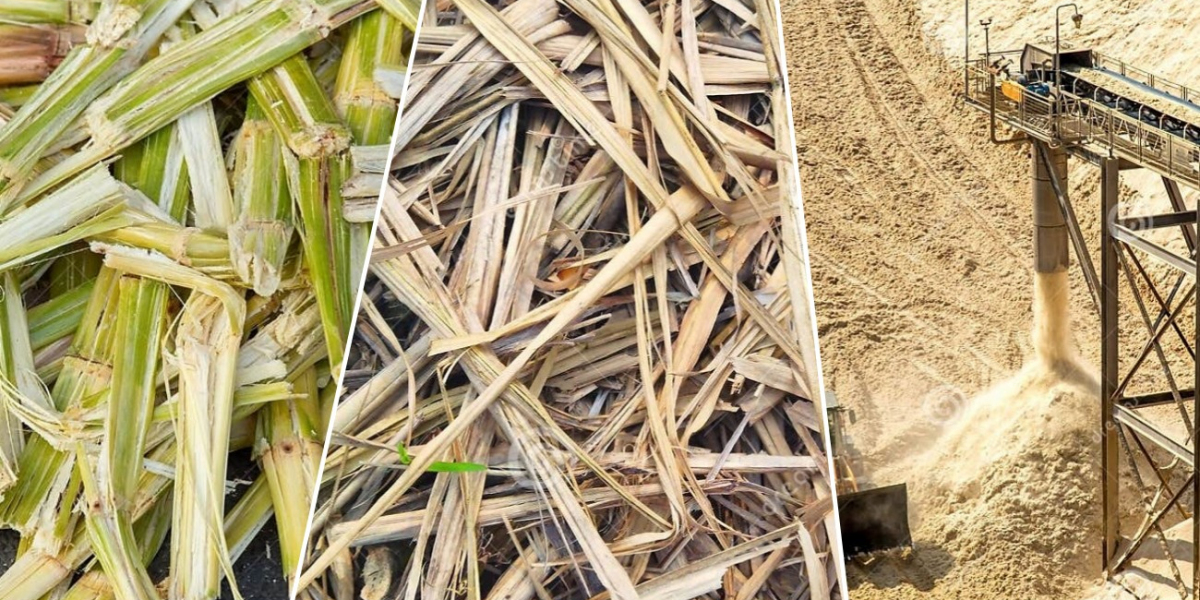In a world increasingly driven by sustainability and eco-consciousness, the reimagining of agricultural byproducts has become a significant step toward reducing waste and conserving resources. One of the most remarkable examples of this transformation is bagasse. Derived from sugarcane waste, bagasse has evolved from a mere byproduct into a versatile material now used in a range of everyday products, including packaging, tableware, and even construction materials.
This article explores the journey of bagasse, from its origins as agricultural waste to its current role in eco-friendly industries. Along the way, we'll delve into how the use of this material has helped address pressing environmental concerns, the technological advancements that have spurred its evolution, and the potential for further innovation.
What is Bagasse?
Bagasse is the fibrous residue left after the extraction of juice from sugarcane. Sugarcane is a major crop, particularly in tropical regions, where it is primarily cultivated for sugar production. The process of crushing sugarcane yields two primary products: sugarcane juice and bagasse. While sugarcane juice is processed into sugar, the bagasse is typically left as waste.
Historically, bagasse was burned as a source of fuel for sugar mills. This helped generate energy, but also led to air pollution and contributed to carbon emissions. Over time, its use has shifted, with bagasse now being recognized for its potential as a renewable resource in various industries.
The Environmental Importance of Bagasse
As global awareness of environmental degradation has grown, industries have increasingly sought alternatives to traditional, unsustainable materials like plastic and Styrofoam. Bagasse has emerged as an attractive solution due to its biodegradability, renewable nature, and minimal environmental impact.
Waste Reduction and Resource Efficiency
One of the most significant environmental benefits of bagasse is its ability to reduce agricultural waste. In sugar-producing countries, millions of tons of bagasse are generated annually. Instead of allowing this material to decompose or burn, repurposing it into valuable products helps minimize waste. This approach exemplifies the principles of a circular economy, where waste is reintegrated into production cycles, reducing the need for new raw materials.
Biodegradability
Unlike plastic and other synthetic materials, bagasse products are fully biodegradable and compostable. Traditional plastics can take hundreds of years to decompose, while bagasse items break down in a matter of months under proper composting conditions. This significantly reduces the burden on landfills and minimizes environmental pollution.
Carbon Neutrality
Bagasse is also considered a carbon-neutral material. When used as a biofuel, it releases only the amount of carbon dioxide that the sugarcane absorbed during its growth cycle, resulting in a balanced carbon footprint. In contrast, burning fossil fuels or producing plastic generates excessive greenhouse gases, contributing to global warming.
The Transformation of Bagasse into Everyday Products
The shift from viewing bagasse as waste to seeing it as a valuable resource is largely due to technological innovations that have enabled its processing into versatile, high-quality products. This transformation has impacted several industries, including packaging, tableware, and even construction.
Bagasse in Packaging Solutions
One of the most widespread applications of bagasse today is in the packaging industry. Given the global outcry over plastic waste, particularly in food packaging, manufacturers have sought biodegradable alternatives. Bagasse has proven to be an ideal material for creating disposable food containers, trays, and other packaging products.
Bagasse packaging is not only eco-friendly but also highly practical. It is resistant to water and oil, making it suitable for a variety of food items. Additionally, it can withstand both high and low temperatures, making it microwave and freezer safe. This versatility has made bagasse packaging a popular choice among eco-conscious businesses and consumers alike.
Tableware Revolution: The Rise of Bagasse Products
Bagasse has also made its mark in the tableware industry, providing an eco-friendly alternative to plastic and Styrofoam plates, bowls, and utensils. In fact, brands like Goldleaf Tableware have started incorporating bagasse in their sustainable product lines, offering consumers stylish, durable, and biodegradable dining solutions.
Bagasse tableware is not only compostable but also aesthetically pleasing. It can be molded into various shapes and sizes, with a smooth finish that appeals to modern consumers. This has positioned bagasse as a preferred material for both casual and formal dining events, from picnics to upscale catering.
Construction and Beyond
While the food industry has been the primary beneficiary of bagasse products, other sectors have also started to recognize its potential. In the construction industry, bagasse is used to manufacture fiberboard, which serves as an alternative to wood. This has far-reaching implications for reducing deforestation, as bagasse can help alleviate the demand for timber.
Bagasse fiberboard is not only eco-friendly but also lightweight, durable, and cost-effective. It can be used in various construction applications, such as wall panels, ceiling tiles, and furniture. As the global construction industry continues to seek sustainable materials, bagasse offers a viable solution with minimal environmental impact.
Technological Advancements in Bagasse Processing
The versatility of bagasse products is largely due to advancements in processing technologies. In the past, bagasse was primarily used as a low-grade fuel, but modern techniques have unlocked its potential for a wide range of applications.
Pulping and Molding Technologies
One of the key breakthroughs has been the development of efficient pulping and molding technologies. Bagasse can be processed into a pulp, which is then molded into various shapes and forms. This process allows for the production of high-quality, durable products that are both functional and sustainable.
The ability to mold bagasse into intricate shapes has opened the door for its use in packaging, tableware, and even custom-designed products like Goldleaf Tableware. With advancements in molding technology, manufacturers can now create complex designs with smooth finishes, rivaling the appearance and performance of plastic or Styrofoam products.
Improved Durability and Resistance
Another important development is the improved durability and resistance of bagasse products. By refining the pulping process and incorporating additives, manufacturers have enhanced the strength, water resistance, and heat tolerance of bagasse-based materials. These improvements have made bagasse products more versatile and suitable for a broader range of applications, from heavy-duty packaging to construction materials.
The Future of Bagasse: Expanding Horizons
The future of bagasse looks promising as industries continue to explore new ways to utilize this sustainable bagasse tableware material. With growing consumer demand for eco-friendly products and stricter regulations on plastic waste, bagasse is poised to play an even larger role in the global shift toward sustainability.
Innovations in Material Science
As research into bagasse continues, we can expect to see further innovations in material science. Scientists are exploring ways to enhance the properties of bagasse, such as improving its mechanical strength and expanding its potential uses. These advancements could lead to the development of new bagasse-based products that outperform traditional materials in both functionality and sustainability.
Expansion into New Industries
While bagasse has already made significant inroads in the food packaging, tableware, and construction industries, its potential extends even further. For instance, bagasse could be used in the production of biodegradable textiles, automotive components, and even electronics. As industries seek to reduce their environmental footprint, bagasse offers a renewable, biodegradable alternative to conventional materials.
Conclusion
The evolution of bagasse from agricultural waste to a valuable resource is a testament to the power of innovation and sustainability. Once considered a byproduct with limited use, bagasse has now become a key player in the fight against environmental degradation. Through advancements in technology, it has been transformed into a versatile material used in a wide range of everyday products, from food packaging to tableware like Goldleaf Tableware.
As the world continues to grapple with the challenges of waste management and resource depletion, the role of bagasse in creating a more sustainable future cannot be overstated. Its biodegradability, renewability, and carbon neutrality make it a compelling solution for industries seeking to reduce their environmental impact. With ongoing innovation, bagasse's potential is only beginning to be realized, promising a greener, more sustainable future for all.









